Unit 1 What's the matter? Section A (1a~2d) 课件(共39张PPT,内嵌音视频) 2023-2024学年人教版英语八年级下册
文档属性
| 名称 | Unit 1 What's the matter? Section A (1a~2d) 课件(共39张PPT,内嵌音视频) 2023-2024学年人教版英语八年级下册 | 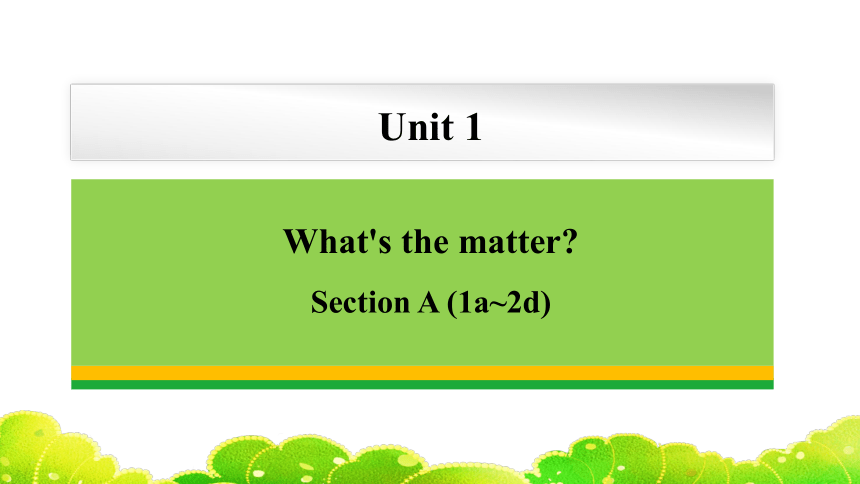 | |
| 格式 | pptx | ||
| 文件大小 | 52.5MB | ||
| 资源类型 | 教案 | ||
| 版本资源 | 人教新目标(Go for it)版 | ||
| 科目 | 英语 | ||
| 更新时间 | 2024-01-01 20:39:38 | ||
图片预览


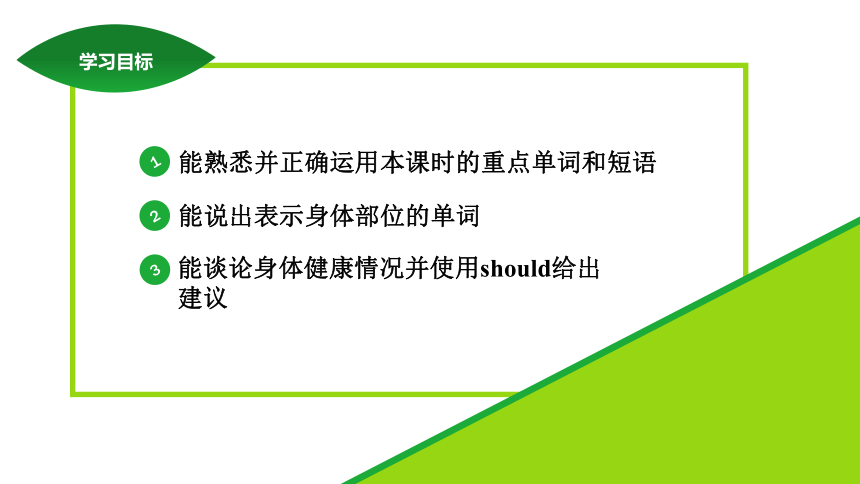
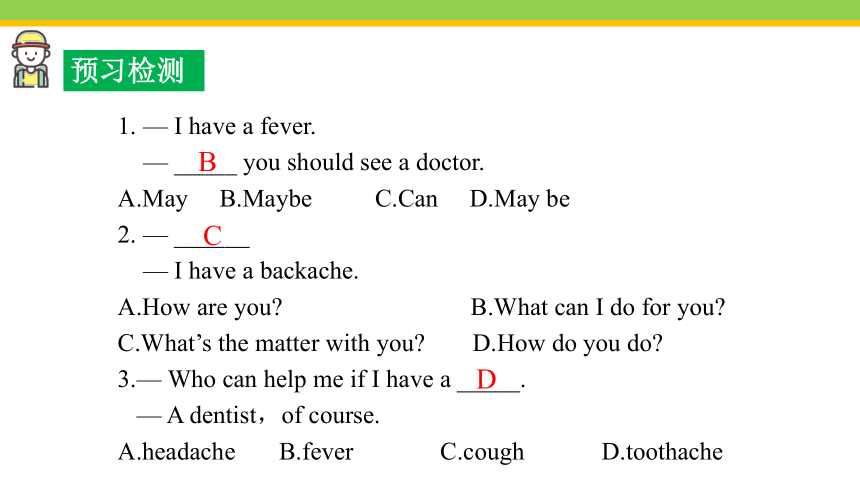
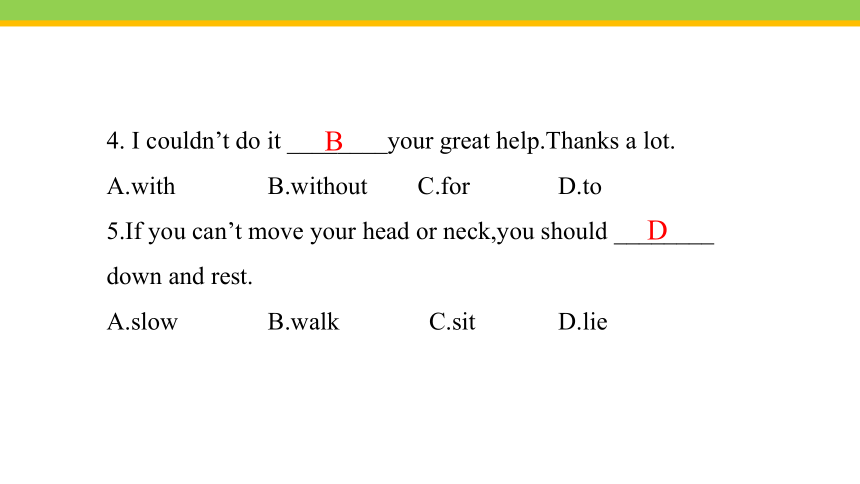
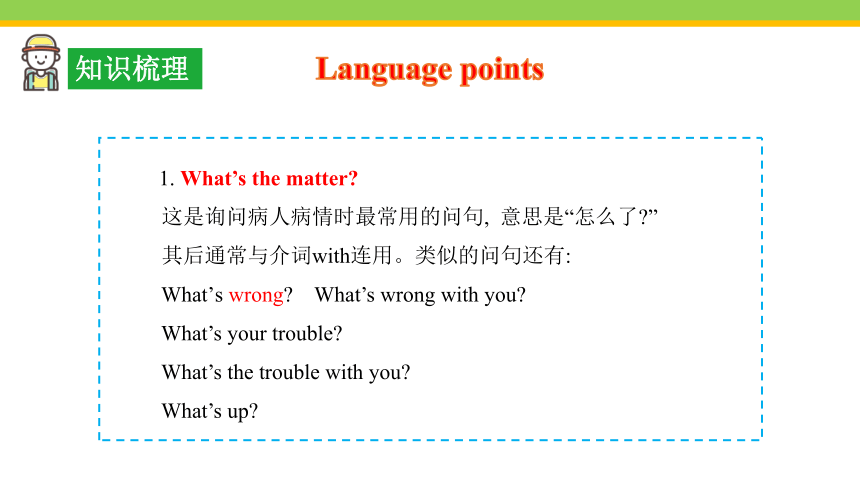
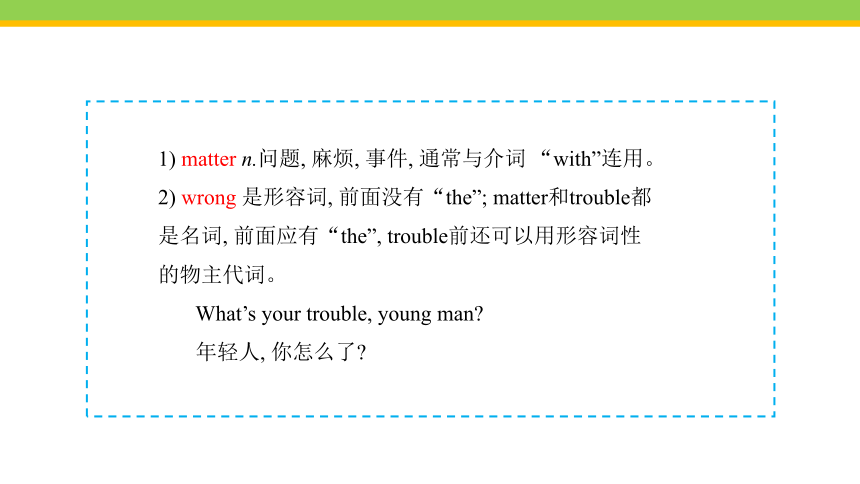
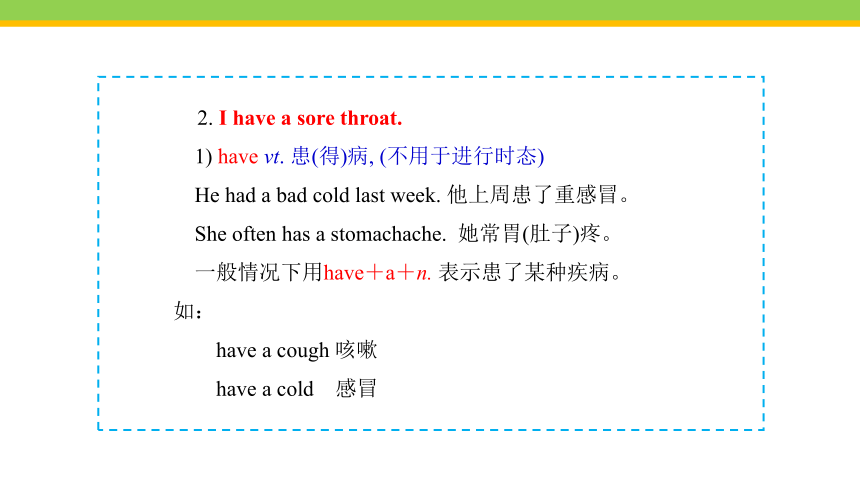

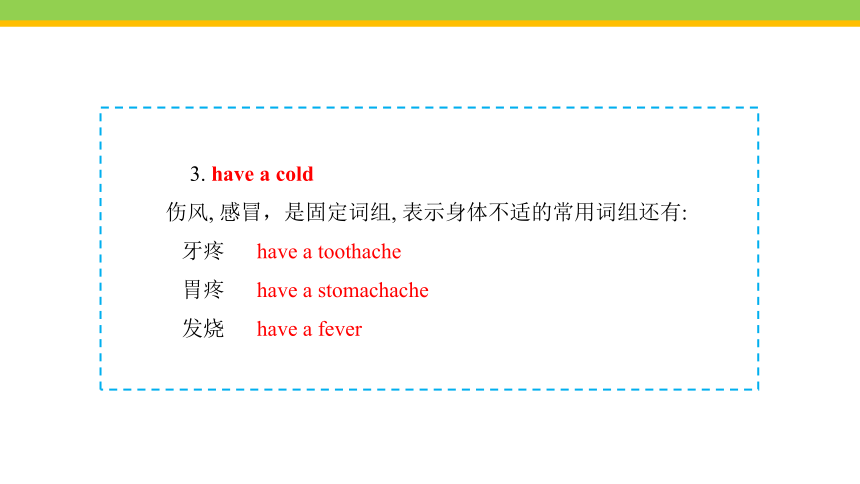
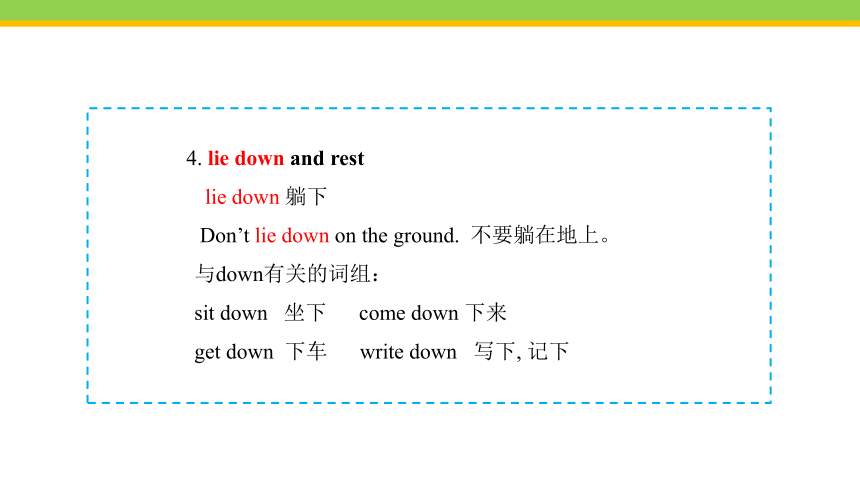
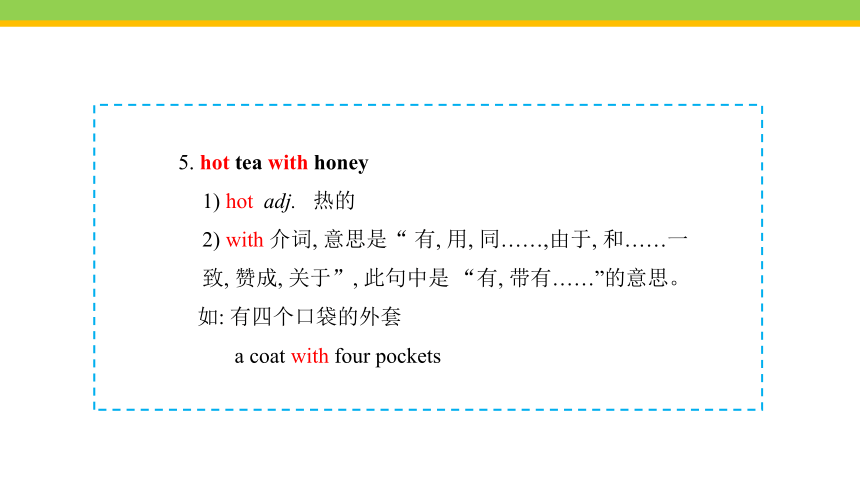
文档简介
(共39张PPT)
Unit 1
What's the matter
Section A (1a~2d)
新课导入
Let's enjoy a video
2
1
能熟悉并正确运用本课时的重点单词和短语
能说出表示身体部位的单词
3
能谈论身体健康情况并使用should给出建议
预习检测
1. — I have a fever.
— _____ you should see a doctor.
A.May B.Maybe C.Can D.May be
2. — ______
— I have a backache.
A.How are you B.What can I do for you
C.What’s the matter with you D.How do you do
3.— Who can help me if I have a _____.
— A dentist,of course.
A.headache B.fever C.cough D.toothache
B
C
D
4. I couldn’t do it ________your great help.Thanks a lot.
A.with B.without C.for D.to
5.If you can’t move your head or neck,you should ________ down and rest.
A.slow B.walk C.sit D.lie
D
B
知识梳理
Language points
1. What’s the matter
这是询问病人病情时最常用的问句, 意思是“怎么了 ”
其后通常与介词with连用。类似的问句还有:
What’s wrong What’s wrong with you
What’s your trouble
What’s the trouble with you
What’s up
1) matter n.问题, 麻烦, 事件, 通常与介词 “with”连用。
2) wrong 是形容词, 前面没有“the”; matter和trouble都
是名词, 前面应有“the”, trouble前还可以用形容词性
的物主代词。
What’s your trouble, young man
年轻人, 你怎么了
2. I have a sore throat.
1) have vt. 患(得)病, (不用于进行时态)
He had a bad cold last week. 他上周患了重感冒。
She often has a stomachache. 她常胃(肚子)疼。
一般情况下用have+a+n. 表示患了某种疾病。
如:
have a cough 咳嗽
have a cold 感冒
2) sore“痛, 疼”, 通常指因发炎引起的肌肉疼, 在表示身
体的某部位疼痛时,常置于部位名词前。
ache常指持续性的疼痛, 它常与身体部位的名词构成
复合词,
如: headache头痛, backache背疼等。
3. have a cold
伤风, 感冒,是固定词组, 表示身体不适的常用词组还有:
牙疼 have a toothache
胃疼 have a stomachache
发烧 have a fever
4. lie down and rest
lie down 躺下
Don’t lie down on the ground. 不要躺在地上。
与down有关的词组:
sit down 坐下 come down 下来
get down 下车 write down 写下, 记下
5. hot tea with honey
1) hot adj. 热的
2) with 介词, 意思是“ 有, 用, 同……,由于, 和……一
致, 赞成, 关于”, 此句中是 “有, 带有……”的意思。
如: 有四个口袋的外套
a coat with four pockets
重点探究
常见的人体各部位英语名称
the names of the body
mouth
nose
ear
eye
tooth
neck
throat
stomach
back
head
arm
hand
leg
foot
eye → ear →
tooth → arm →
hand → leg →
foot →
牙、脚变复数,
双o变双e
eyes
ears
arms
legs
teeth
hands
feet
复数
ear
arm
hand
leg
foot
eye
nose
mouth
tooth(teeth)
face
stomach
back
Parts of body
head
Follow me:
Everybody moves your body
Nod your head and touch your face
Touch your nose and close your eyes
Touch your ears and clap your hands
Raise your arms and look at your back
Touch your stomach and tap your foot
Sit down and move your legs
1a. Look at the picture. Write the correct letter [a-m]
for each part of the body.
___ arm ___ back
___ ear ___ eye
___ foot ___ hand
___ head ___ leg
___ mouth ___ neck
___ nose
___ stomach
___ tooth
h
e
g
i
b
a
j
l
c
d
m
k
f
活动小结
当堂检测见DCF课件
通过以上的活动,我们巩固复习了一些描述人身体部位的单词,如:1.______,______,______,______,______,______,______,______,______,______;我们还学习了几个新的身体部位的单词2.______,______,__________,______。
arm
hand
nose
head
ear
back
leg
eye
mouth
tooth
foot
neck
stomach
throat
询问及谈论自己和他人的病情
What’s the matter with him
He has a headache.
He has a toothache.
He has a stomachache.
He has a sore back.
He has a sore neck.
She has a sore throat.
What’s the matter with him
1b. Listen and look at the picture. Then number the
names [1-5].
Nancy ___
Sarah ___
David ___
Ben _____
Judy ____
1
3
2
5
4
Pair work
1c. Look at the picture. What are their problems
Make conversations.
What’s the matter with Judy
She talked too much yesterday and didn’t drink enough water. She has a very sore throat now.
What’s the matter with him
He has a toothache.
活动小结
当堂检测见DCF课件
通过以上的活动,我们可以知道:询问他人的病情我们通常用句型“1.______________________________ ”,类似的句型还有:What’s wrong (with+主语) /What’s the trouble (with+主语) /What’s one’s trouble /What’s up 。have表示具有某种“病症;症状”时,常用于“2.___________________”结构。例如:have a cold, have a headache.其中have要根据人称或时态做出相应的变化。
What’s the matter(with+主语)
have a/an +病症名词
描述身体状况并运用should来表达建议
I have a cold.What should I do
You should
lie down and rest.
(躺下) (休息)
wear warm clothes.(穿暖一点)
drink more water.(多喝水)
drink lots of water.(多喝水)
take some medicine.(吃药)
You should
see a dentist.
去看牙医
get an X-ray.
拍片子
I have a toothache. What should I do
I have a fever. I have a headache. What should I do
You should
take your temperature.(量体温)
take some medicine.(吃药)
drink more hot water.(喝热水)
lie down and rest.(躺下休息)
Pair work
A: What’s the matter with him/her
B: He/She has a...
A: What should he/she do
B: He/She should...
2a. Listen and number the pictures [1-5]in the order
you hear them.
1
2
3
4
5
2b. Listen again. Match the problems with the advice.
1.fever a. lie down and rest
2.stomachache b. drink some hot tea with honey
3. cough and sore throat c. see a dentist and get an X-ray
4.toothache d. take your temperature
5.cut myself e. put some medicine on it
Listen again. Fill in the blanks.
Problem Reason Advice
fever /
stomachache
cough and sore throat
toothache /
cut myself
take your temperature
didn't wear enough warm clothes
put some medicine on it
see a dentist and get an X-ray
by accident
lie down and rest
drink some hot tea with honey
ate too much
Pair work
Make conversations using the information in 2a and 2b.
A: What’s the matter
B: My head feels very hot.
A: Maybe you have a fever …
B: ...
Role-play
2d
Mandy: Lisa, are you OK
Lisa: I have a headache and I can’t move my neck. What
should I do Should I take my temperature
Mandy: No, it doesn’t sound like you have a fever. What did you do on the weekend
Lisa: I played computer games all the weekend.
Mandy: That’s probably why. You need to take breaks
away from the computer.
Lisa: Yeah, I think I sat in the same way for too long without moving.
Mandy: I think you should lie down and rest. If your head and neck
still hurt tomorrow, then go to a doctor.
Lisa: OK. Thanks, Mandy.
活动小结
当堂检测见DCF课件
通过以上的活动,我们学习了如何描述身体状况以及用should来表达建议,其中情态动词should 意为
“1. _______________”,常用以表达职责和义务,提出劝告其后接2. _______________。
should 的否定形式是should not/shouldn’t, 意为
“3. _______________”。
应该;应当;可以
动词原形
不应当;不该
一、单词填空。
当堂检测
1.We hear with our e______ and see with our e______.
2.You look pale. You ______ (应该)lie down and rest.
3.Don’t l ______ down on the ground.
4.She has a sore throat.She should drink some hot tea with h ______.
ars
yes
should
ie
oney
二、完成句子。
1.我妹妹喜欢喝加蜂蜜的牛奶。
My sister likes drinking milk _______ _______ .
2.他不应该吃任何东西。
He _______ _______ _______.
3.他喉咙痛。他应该多喝水。
He has a sore throat.He should _______ _______ _______ _______.
4.如果你的头和脖子明天仍然疼的话,请去看医生。
If your head and neck _______ _______tomorrow, then _______ _______ _______.
with milk
shouldn’t eat anything
still hurt
see a
doctor
drink lots of water
课堂总结
询问他人的病情我们通常用句型“1.______________________________ ”,类似的句型还有:What’s wrong (with+主语) /What’s the trouble (with+主语) /What’s one’s trouble /What’s up 。have表示具有某种“病症;症状”时,常用于“2.___________________”结构。例如:have a cold, have a headache.其中have要根据人称或时态做出相应的变化。
Unit 1
Section A (1a~2d)
表示人身体部位的单词:
______________________,
______________________,
______________________,
______________________,
______________________.
arm back ear eye foot hand head leg mouth
neck nose stomach tooth
What’s the matter(with+主语)
have a/an +病症名词
Unit 1
What's the matter
Section A (1a~2d)
新课导入
Let's enjoy a video
2
1
能熟悉并正确运用本课时的重点单词和短语
能说出表示身体部位的单词
3
能谈论身体健康情况并使用should给出建议
预习检测
1. — I have a fever.
— _____ you should see a doctor.
A.May B.Maybe C.Can D.May be
2. — ______
— I have a backache.
A.How are you B.What can I do for you
C.What’s the matter with you D.How do you do
3.— Who can help me if I have a _____.
— A dentist,of course.
A.headache B.fever C.cough D.toothache
B
C
D
4. I couldn’t do it ________your great help.Thanks a lot.
A.with B.without C.for D.to
5.If you can’t move your head or neck,you should ________ down and rest.
A.slow B.walk C.sit D.lie
D
B
知识梳理
Language points
1. What’s the matter
这是询问病人病情时最常用的问句, 意思是“怎么了 ”
其后通常与介词with连用。类似的问句还有:
What’s wrong What’s wrong with you
What’s your trouble
What’s the trouble with you
What’s up
1) matter n.问题, 麻烦, 事件, 通常与介词 “with”连用。
2) wrong 是形容词, 前面没有“the”; matter和trouble都
是名词, 前面应有“the”, trouble前还可以用形容词性
的物主代词。
What’s your trouble, young man
年轻人, 你怎么了
2. I have a sore throat.
1) have vt. 患(得)病, (不用于进行时态)
He had a bad cold last week. 他上周患了重感冒。
She often has a stomachache. 她常胃(肚子)疼。
一般情况下用have+a+n. 表示患了某种疾病。
如:
have a cough 咳嗽
have a cold 感冒
2) sore“痛, 疼”, 通常指因发炎引起的肌肉疼, 在表示身
体的某部位疼痛时,常置于部位名词前。
ache常指持续性的疼痛, 它常与身体部位的名词构成
复合词,
如: headache头痛, backache背疼等。
3. have a cold
伤风, 感冒,是固定词组, 表示身体不适的常用词组还有:
牙疼 have a toothache
胃疼 have a stomachache
发烧 have a fever
4. lie down and rest
lie down 躺下
Don’t lie down on the ground. 不要躺在地上。
与down有关的词组:
sit down 坐下 come down 下来
get down 下车 write down 写下, 记下
5. hot tea with honey
1) hot adj. 热的
2) with 介词, 意思是“ 有, 用, 同……,由于, 和……一
致, 赞成, 关于”, 此句中是 “有, 带有……”的意思。
如: 有四个口袋的外套
a coat with four pockets
重点探究
常见的人体各部位英语名称
the names of the body
mouth
nose
ear
eye
tooth
neck
throat
stomach
back
head
arm
hand
leg
foot
eye → ear →
tooth → arm →
hand → leg →
foot →
牙、脚变复数,
双o变双e
eyes
ears
arms
legs
teeth
hands
feet
复数
ear
arm
hand
leg
foot
eye
nose
mouth
tooth(teeth)
face
stomach
back
Parts of body
head
Follow me:
Everybody moves your body
Nod your head and touch your face
Touch your nose and close your eyes
Touch your ears and clap your hands
Raise your arms and look at your back
Touch your stomach and tap your foot
Sit down and move your legs
1a. Look at the picture. Write the correct letter [a-m]
for each part of the body.
___ arm ___ back
___ ear ___ eye
___ foot ___ hand
___ head ___ leg
___ mouth ___ neck
___ nose
___ stomach
___ tooth
h
e
g
i
b
a
j
l
c
d
m
k
f
活动小结
当堂检测见DCF课件
通过以上的活动,我们巩固复习了一些描述人身体部位的单词,如:1.______,______,______,______,______,______,______,______,______,______;我们还学习了几个新的身体部位的单词2.______,______,__________,______。
arm
hand
nose
head
ear
back
leg
eye
mouth
tooth
foot
neck
stomach
throat
询问及谈论自己和他人的病情
What’s the matter with him
He has a headache.
He has a toothache.
He has a stomachache.
He has a sore back.
He has a sore neck.
She has a sore throat.
What’s the matter with him
1b. Listen and look at the picture. Then number the
names [1-5].
Nancy ___
Sarah ___
David ___
Ben _____
Judy ____
1
3
2
5
4
Pair work
1c. Look at the picture. What are their problems
Make conversations.
What’s the matter with Judy
She talked too much yesterday and didn’t drink enough water. She has a very sore throat now.
What’s the matter with him
He has a toothache.
活动小结
当堂检测见DCF课件
通过以上的活动,我们可以知道:询问他人的病情我们通常用句型“1.______________________________ ”,类似的句型还有:What’s wrong (with+主语) /What’s the trouble (with+主语) /What’s one’s trouble /What’s up 。have表示具有某种“病症;症状”时,常用于“2.___________________”结构。例如:have a cold, have a headache.其中have要根据人称或时态做出相应的变化。
What’s the matter(with+主语)
have a/an +病症名词
描述身体状况并运用should来表达建议
I have a cold.What should I do
You should
lie down and rest.
(躺下) (休息)
wear warm clothes.(穿暖一点)
drink more water.(多喝水)
drink lots of water.(多喝水)
take some medicine.(吃药)
You should
see a dentist.
去看牙医
get an X-ray.
拍片子
I have a toothache. What should I do
I have a fever. I have a headache. What should I do
You should
take your temperature.(量体温)
take some medicine.(吃药)
drink more hot water.(喝热水)
lie down and rest.(躺下休息)
Pair work
A: What’s the matter with him/her
B: He/She has a...
A: What should he/she do
B: He/She should...
2a. Listen and number the pictures [1-5]in the order
you hear them.
1
2
3
4
5
2b. Listen again. Match the problems with the advice.
1.fever a. lie down and rest
2.stomachache b. drink some hot tea with honey
3. cough and sore throat c. see a dentist and get an X-ray
4.toothache d. take your temperature
5.cut myself e. put some medicine on it
Listen again. Fill in the blanks.
Problem Reason Advice
fever /
stomachache
cough and sore throat
toothache /
cut myself
take your temperature
didn't wear enough warm clothes
put some medicine on it
see a dentist and get an X-ray
by accident
lie down and rest
drink some hot tea with honey
ate too much
Pair work
Make conversations using the information in 2a and 2b.
A: What’s the matter
B: My head feels very hot.
A: Maybe you have a fever …
B: ...
Role-play
2d
Mandy: Lisa, are you OK
Lisa: I have a headache and I can’t move my neck. What
should I do Should I take my temperature
Mandy: No, it doesn’t sound like you have a fever. What did you do on the weekend
Lisa: I played computer games all the weekend.
Mandy: That’s probably why. You need to take breaks
away from the computer.
Lisa: Yeah, I think I sat in the same way for too long without moving.
Mandy: I think you should lie down and rest. If your head and neck
still hurt tomorrow, then go to a doctor.
Lisa: OK. Thanks, Mandy.
活动小结
当堂检测见DCF课件
通过以上的活动,我们学习了如何描述身体状况以及用should来表达建议,其中情态动词should 意为
“1. _______________”,常用以表达职责和义务,提出劝告其后接2. _______________。
should 的否定形式是should not/shouldn’t, 意为
“3. _______________”。
应该;应当;可以
动词原形
不应当;不该
一、单词填空。
当堂检测
1.We hear with our e______ and see with our e______.
2.You look pale. You ______ (应该)lie down and rest.
3.Don’t l ______ down on the ground.
4.She has a sore throat.She should drink some hot tea with h ______.
ars
yes
should
ie
oney
二、完成句子。
1.我妹妹喜欢喝加蜂蜜的牛奶。
My sister likes drinking milk _______ _______ .
2.他不应该吃任何东西。
He _______ _______ _______.
3.他喉咙痛。他应该多喝水。
He has a sore throat.He should _______ _______ _______ _______.
4.如果你的头和脖子明天仍然疼的话,请去看医生。
If your head and neck _______ _______tomorrow, then _______ _______ _______.
with milk
shouldn’t eat anything
still hurt
see a
doctor
drink lots of water
课堂总结
询问他人的病情我们通常用句型“1.______________________________ ”,类似的句型还有:What’s wrong (with+主语) /What’s the trouble (with+主语) /What’s one’s trouble /What’s up 。have表示具有某种“病症;症状”时,常用于“2.___________________”结构。例如:have a cold, have a headache.其中have要根据人称或时态做出相应的变化。
Unit 1
Section A (1a~2d)
表示人身体部位的单词:
______________________,
______________________,
______________________,
______________________,
______________________.
arm back ear eye foot hand head leg mouth
neck nose stomach tooth
What’s the matter(with+主语)
have a/an +病症名词
同课章节目录
- Unit 1 What's the matter?
- Section A
- Section B
- Unit 2 I'll help to clean up the city parks.
- Section A
- Section B
- Unit 3 Could you please clean your room?
- Section A
- Section B
- Unit 4 Why don't you talk to your parents?
- Section A
- Section B
- Unit 5 What were you doing when the rainstorm came
- Section A
- Section B
- Review of Units 1-5
- Unit 6 An old man tried to move the mountains.
- Section A
- Section B
- Unit 7 What's the highest mountain in the world?
- Section A
- Section B
- Unit 8 Have you read Treasure Island yet?
- Section A
- Section B
- Unit 9 Have you ever been to a museum?
- Section A
- Section B
- Unit 10 I've had this bike for three years.
- Section A
- Section B
